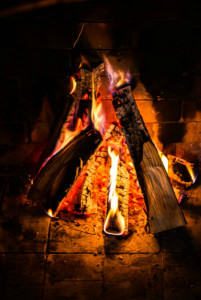Your chimney is clean, your firewood is stacked and you are ready to add to your home’s warmth this winter with your wood-burning fireplace. Before you light a fire, you should make sure you’re burning the right type of firewood this season to provide the warmest and safest fires possible.
Properly seasoned firewood
The most important thing you can do to make sure your wood is fire ready is to make sure it has been properly seasoned. Properly seasoned firewood has been allowed to rest for at least six month after being chopped before it’s burned. After a tree is cut, water remains in the series of tubes the nurture the living tree. The weight of a freshly cut log is up to 45 percent water. Properly seasoned firewood, however, has a water content to between 20 and 25 percent.
The importance of properly seasoned firewood
Firewood that hasn’t been properly seasoned burns less efficiently and decreases the amount of heat your fireplace releases into your home. When you burn wet firewood, much of your fire’s energy goes into evaporating the water that remains in the wood. That means your fire is significantly cooler.
That cooler, wet fire also produces a lot of smoke, which introduces more pollution into your home, especially if you have an open-hearth fireplace. The cooler, heavier smoke causes a more dangerous problem, however. Cooler fires with lots of smoke increase creosote buildup within your chimney. Creosote, a highly flammable, sticky substance, is the leading cause of chimney fires.
Tips for properly seasoning your firewood
If you harvest your own firewood, you’ll need to prep it and stack it properly to make sure it’s ready for the fire-burning season. Your tree should be cut into logs that are appropriately sized for your fireplace, generally 3 to 6 inches shorter than the firebox. Then the logs should be split to 3 to 6 inches wide. Stack the split wood in a sunny place where the wind can blow through the woodpile. While your firewood is seasoning, leave it uncovered so the elements can help it dry out. Once the seasoning process is finished, your wood pile should be covered to prevent it from reabsorbing water from rain or snow.
You will be able to tell if your wood is properly seasoned because the wood will be yellow or brown and slightly cracked, and the bark will become loose. Properly seasoned wood will feel lighter, and if you strike two pieces of wood together, you will hear a drum-like sound, rather than a dull thud. The most obvious sign that your firewood still contains too much water is that it lets off a strong hissing sound when burned as the water inside evaporates. Properly seasoned firewood lets a pleasant crackling sound.
While it sounds complicated, properly seasoning your firewood, or making sure that the wood you’ve purchased is properly seasoned, is a simple way to make sure you’re burning the right wood this winter to produce as much heat as possible from your fireplace and keep your family safe.
